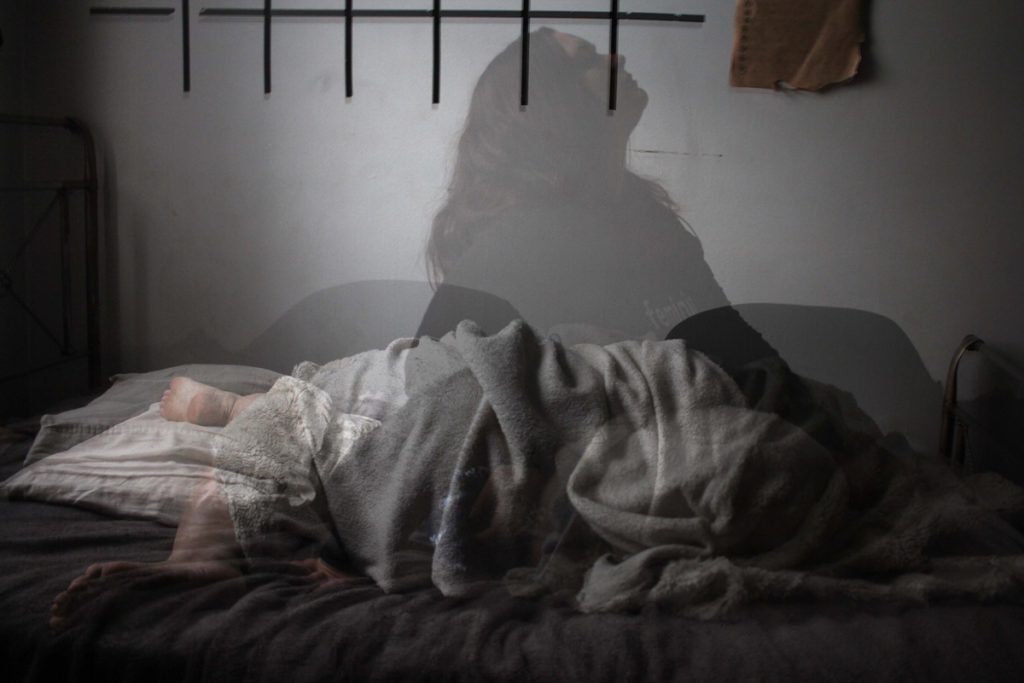I’m awake again. Were those coyotes howling, or was that just a dream? It’s four o’clock in the morning, and it is often difficult to tell what is a dream and what isn’t. I lie here in bed, hearing my husband gently snoring next to me, my body warmly nestled, but my mind is moving, constantly moving.
Since childhood, I’ve always been an insomniac. Being awake in the middle of the night is part of my psychological and spiritual landscape, part of my wholeness. But it is often excruciating, full of edginess and disparagement. Insomnia keeps me close to my pulse. And it is always a practice.
What is the worst that can happen? My nightlife tells me in graphic detail. My dean is mad at me, wants to see me tomorrow. I can see every crease of his face, hear the strain in his voice expressing the awful truth he prepares to tell me. Under the tether of night, I cannot escape—my body aches and my mind churns. I cannot stir without waking my husband. But the dreaded scenario is not content for just one performance. Its sequels embellish the painful details, sometimes building to a crescendo of calamity after calamity. It is no wonder that most insomniacs pursue pills, relaxation exercises, natural remedies, and “white sound” machines to induce that precious uninterrupted slumber.
I remember a traditional Tibetan insomnia-cure visualization. Imagine it is night deep in the forest. A raging river rushes through a narrow gorge, roaring incessantly. At the top of the gorge there is a coarse rope ladder descending from the rim halfway down to a small and cozy cave in the canyon wall. Inside is a crackling campfire burning, illuminating and warming the rough stone walls of the cave. I am sitting before the fire wrapped in a sheepskin cloak, cuddling a baby goat nestled into my arms. Even as I hear the roaring river, I hold the kid close and feel content. I have always loved this visualization, and used to practice it nightly. But it really never put me to sleep. Though it holds no promise, it is nice to remember this practice tonight.
Yet, lying here I connect with something deeper about this jumpy wakefulness. There is something delicious about exposing myself to the deepest recesses of my mind, watching my mood careen into anxiety, depression, or excitement, and eventually returning to a sense of relief and rest. I used to apply mindfulness methods in the night, gently training my mind to retract from its extremes. Or I would get up and sit, settling myself into simplicity. But the discipline would often feed my anxiety when I returned to the pillow.
Now, after all these years, most of the time I just lie here. I’m lying here tonight, watching the movements of my mind, dispassionately expanding into scenarios and moods. Rinpoche used to call this the bardo, the in-between state. There is tremendous uncertainty and groundlessness, what he used to call a “highlight in the middle of nowhere.” I’m in between wakefulness and sleep, in between fantasy and reality. I really have no idea what is real, and every movement of my mind has the potential to devastate me. But there is something powerful about just letting it all happen. Just watching my mind shift, letting it go. Allowing the unfabricated qualities to shine out.
Part of my practice is to give up trying to go back to sleep. No breathing exercises, no sleep-inducing imagery. Just lie here resting and very still, permitting my mind its various tendencies. Sometimes I drift into dream-like states, sometimes discursiveness and planning take over. Tremendous anxiety arises—am I prepared for my morning class’ Have I arranged for my daughter’s ride, or my son’s volleyball game? Mounting anxiety about all the things left undone, and my body tenses up, my shoulders big round fists. And then everything releases and relaxes, back into the ambiguity. Within the intensity of my thoughts and emotions I discover the non-intensity of my mind, the vast and spacious qualities which pervade all my suffering. The anxiety dissipates. No amount of effort would have lessened the anxiety, and waiting for anxiety to wear out takes hours.
In this bardo, I feel the boundaries of my being become porous, permeable, dissolve. I lie here, expanding into the blackness, letting my body rest, my mind open. Oceanically, I feel waves of emotion—fear, joy, sadness—wash through me, and I feel connected with every living being. Somewhere this very moment, babies are born, fathers are dying, mothers are grieving. Yet, pervading all is a groundless awareness, delicate and strong at the same time. Everything becomes we, a beating heart with a transparent, radiant smile. And we are awake.
Thank you for subscribing to Tricycle! As a nonprofit, we depend on readers like you to keep Buddhist teachings and practices widely available.
